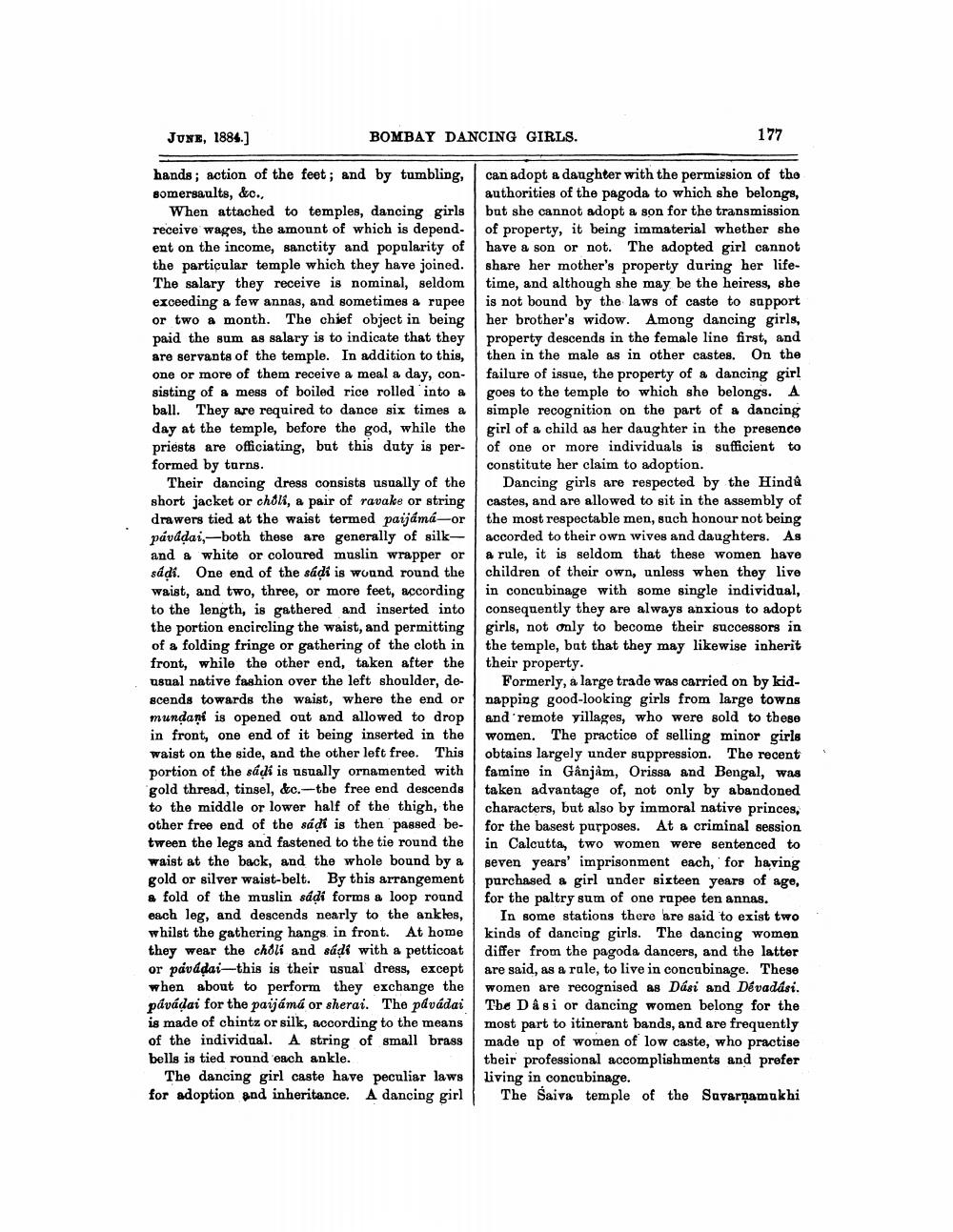________________
BOMBAY DANCING GIRLS.
JUNE, 1884.]
hands; action of the feet; and by tumbling, somersaults, &c.,
When attached to temples, dancing girls receive wages, the amount of which is dependent on the income, sanctity and popularity of the particular temple which they have joined. The salary they receive is nominal, seldom exceeding a few annas, and sometimes a rupee or two a month. The chief object in being paid the sum as salary is to indicate that they are servants of the temple. In addition to this, one or more of them receive a meal a day, consisting of a mess of boiled rice rolled into a ball. They are required to dance six times a day at the temple, before the god, while the priests are officiating, but this duty is performed by turns.
Their dancing dress consists usually of the short jacket or choli, a pair of ravake or string drawers tied at the waist termed paijámá-or páváḍai, both these are generally of silkand a white or coloured muslin wrapper or sádí. One end of the sádi is wound round the waist, and two, three, or more feet, according to the length, is gathered and inserted into the portion encircling the waist, and permitting of a folding fringe or gathering of the cloth in front, while the other end, taken after the usual native fashion over the left shoulder, descends towards the waist, where the end or mundant is opened out and allowed to drop in front, one end of it being inserted in the waist on the side, and the other left free. This portion of the sádi is usually ornamented with gold thread, tinsel, &c.-the free end descends to the middle or lower half of the thigh, the other free end of the sádi is then passed between the legs and fastened to the tie round the waist at the back, and the whole bound by a gold or silver waist-belt. By this arrangement a fold of the muslin sádi forms a loop round each leg, and descends nearly to the ankles, whilst the gathering hangs in front. At home they wear the cholí and súdi with a petticoat or páváḍai-this is their usual dress, except when about to perform they exchange the páváḍai for the paijámú or sherai. The pávádai is made of chintz or silk, according to the means of the individual. A string of small brass bells is tied round each ankle.
The dancing girl caste have peculiar laws for adoption and inheritance. A dancing girl
177
can adopt a daughter with the permission of the authorities of the pagoda to which she belongs, but she cannot adopt a son for the transmission of property, it being immaterial whether she have a son or not. The adopted girl cannot share her mother's property during her lifetime, and although she may be the heiress, she is not bound by the laws of caste to support her brother's widow. Among dancing girls, property descends in the female line first, and then in the male as in other castes. On the failure of issue, the property of a dancing girl goes to the temple to which she belongs. A simple recognition on the part of a dancing girl of a child as her daughter in the presence of one or more individuals is sufficient to constitute her claim to adoption.
Dancing girls are respected by the Hindu castes, and are allowed to sit in the assembly of the most respectable men, such honour not being accorded to their own wives and daughters. As a rule, it is seldom that these women have children of their own, unless when they live in concubinage with some single individual, consequently they are always anxious to adopt girls, not only to become their successors in the temple, but that they may likewise inherit their property.
Formerly, a large trade was carried on by kidnapping good-looking girls from large towns and remote villages, who were sold to these women. The practice of selling minor girls obtains largely under suppression. The recent famine in Gânjam, Orissa and Bengal, was taken advantage of, not only by abandoned characters, but also by immoral native princes, for the basest purposes. At a criminal session in Calcutta, two women were sentenced to seven years' imprisonment each, for having purchased a girl under sixteen years of age, for the paltry sum of one rupee ten annas.
In some stations there are said to exist two kinds of dancing girls. The dancing women differ from the pagoda dancers, and the latter are said, as a rule, to live in concubinage. These women are recognised as Dási and Dévadási. The Dâ si or dancing women belong for the most part to itinerant bands, and are frequently made up of women of low caste, who practise their professional accomplishments and prefer living in concubinage.
The Saiva temple of the Suvarnamukhi




